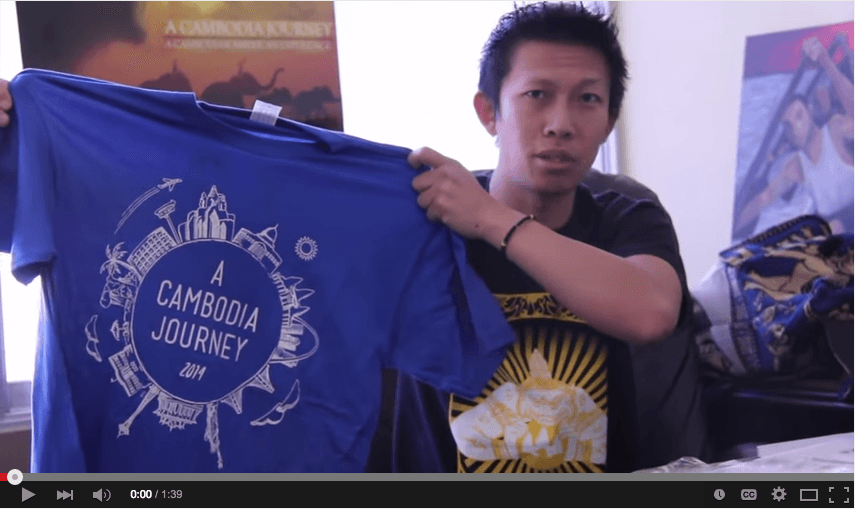How ‘Khmerican’ connects Cambodian Americans
Meet Khmerican CEO and founder Derek Phan.
Phatry Derek Pan first heard the term "Khmerican" in the mid-90s when Phanit Duong used the term to describe a martial arts kick.
In 2003, he began using the word atThe Phnom Penh Post as a catchy way to identify a Cambodian American. When his then-girlfriend held a photo shoot called, "I am Khmerican," Pan wrote a profile titled, "Rapper In Search of the Khmerican Dream."
Nobody knew that the term would become the name of the leading online media outlet for Cambodian Americans. Not even Pan himself, now the CEO and co-founder of Khmerican.com.
Pan's then-girlfriend purchased the Khmerican web domain and Pan continued to renew the domain for years, not knowing exactly what he would do with it. After six years of reporting in Cambodia and then returning to the United States, it hit him.
"Why aren't Cambodians in these other communities aware of what is going on?" Pan says. "Why was Philadelphia stuck in its own bubble and not knowing what Lowell Cambodians were doing, people who were running for office, people who were winning?" In 2011, he called a lifelong friend and said, "Make a website for Khmerican."
Once those plans were in motion, Pan flipped through his contact book and called his friends living in different regions to help write stories and take photographs of Cambodian American news happening across the United States. Khmerican was born.
"I realized what Khmerican stood for," Pan says. "One hundred years from now, people might say we were the first historians of Khmer America."
Pan, who had left Cambodia as a refugee when he was 4, grew up in a family of nine in Kelso, Washington, outside Seattle, one of several enclaves of Cambodian Americans. They had settled in the United States after the 1975 takeover of the Khmer Rouge, which killed nearly a quarter of the nation's population in its four years in power. After setting his website in motion, Pan moved to Long Beach, California, the city with the most Cambodians outside of Cambodia. "This was the epicenter of Khmer America," he says.
Khmerican was soon reaching an average of 750,000 readers each month, according to Pan. The website gave Cambodians who grew up in the United States something they weren't able to get anywhere else: Images of themselves.
"Mainstream media typically produce the same visuals about Cambodian Americans as gang members, troubled, and survivors of the genocide. We want to change the landscape of how the world views us," said Pan.
Khmerican was one of the first media outlets to showcase images of success — an entrepreneur, a model or a rapper. The website features successful Cambodian Americans, from rapper praCh Ly and filmmaker Caylee So, who created the first ever Cambodia Town Film Festival in 2013, to Brooklyn-based comedian Hella Chluy. Khmerican also featured a profile of half-French half Cambodian fashion model Daphnee Lucenet, who also has degrees in IT engineering and business.
On Facebook, it publicizes student cultural shows. This month, it will commemorate the 40th anniversary of the start of the Khmer Rogue regime and the genocide. Among the events it is covering: remembrances at colleges in Riverside, Calif., on April 15 and Boston on April 17.
With Khmerican acting as a hub for Cambodian-American news, it has also gained a diverse readership that expanded beyond the Cambodian community. Today, two-thirds of the readers are not of Cambodian descent, according to Pan. Readers in the US make up about half of the audience, and about one-fifth of the audience are in Cambodia. The remaining percentage comes from the Cambodian diaspora around the world, including from Australia, Canada and France.
Pan says the next step is to expand the Khmerican brand to Cambodia. Cambodian Americans will still be featured on the site, but Pan plans to add reporting from of Cambodia in English, targeting the growing population of Cambodian Americans living in Cambodia who don't speak Khmer. Pan believes this reporting will influence Cambodian Americans to return to Cambodia and give back to Cambodia's revival.
Also in the works are plans to launch a sister company called Aneakajun. Aneakajun is a Cambodian word that roughly translates into a traitor or one who abandoned his roots. It's a term that Cambodians in Cambodia have used pejoratively to describe those who left the country and never returned. Pan hopes to reclaim the word by showcasing the positive contributions that Southeast Asian Americans have made to their home countries. Aneakajun's focus will include all oversea Cambodians (e.g. Khmer Americans, Khmer French, Khmer Australian, etc.) in Cambodia.
"When Cambodians got independence in 1953 from France, Cambodians had the opportunity to study abroad, mostly to European countries, here to Long Beach and other Western countries. When they finished their studies, a small percentage actually stayed in France, Australia, US and people back at home called them traitors."
This story was produced by VoiceWaves, a Long Beach youth-led media project of New America Media, as part of a collaboration between PRI's The World and New America Media.
We want to hear your feedback so we can keep improving our website, theworld.org. Please fill out this quick survey and let us know your thoughts (your answers will be anonymous). Thanks for your time!
